Intracellular sodium - Study guides, Class notes & Summaries
Looking for the best study guides, study notes and summaries about Intracellular sodium? On this page you'll find 4936 study documents about Intracellular sodium.
Page 3 out of 4.936 results
Sort by
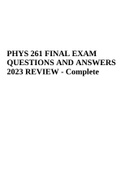
-
PHYS 261 FINAL EXAM QUESTIONS AND ANSWERS 2023 REVIEW - Complete Solution
- Exam (elaborations) • 18 pages • 2023
- Available in package deal
-
- $18.49
- 2x sold
- + learn more
PHYS 261 FINAL EXAM QUESTIONS AND ANSWERS 2023 REVIEW - Complete. An allosteric modulator binds to A) the active site. B) the product. C) a region of the enzyme other than the active site. D) the surrounding tissue. E) the substrate. 10) Permeability is a property of A) solutes. B) solvents. C) ions. D) membranes. E) proteins. 11) What are the two extracellular fluid compartments in the body? A) plasma and the fluid portion of the blood B) intracellular and plasma C) plasma and in...
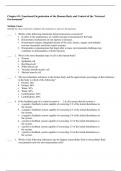
-
Test Bank for Guyton and Hall Textbook of Medical Physiology, 14th Edition by Hall
- Exam (elaborations) • 380 pages • 2023
-
- $29.49
- 2x sold
- + learn more
Test Bank for Guyton and Hall Textbook of Medical Physiology, 14th Edition 14e by John E. Hall, Michael E. Hall. Full Chapters test bank are included Chap 1 to 85 (Complete Chapters) I. Introduction to Physiology: The Cell and General Physiology 1. Functional Organization of the Human Body and Control of the "Internal Environment" 2. The Cell and Its Functions 3. Genetic Control of Protein Synthesis, cell function, and cell reproduction II. Membrane Physiology, Nerve, and Mus...
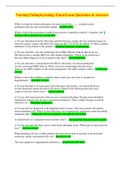
-
Nursing Pathophysiology Final Exam Questions & Answers
- Exam (elaborations) • 19 pages • 2023
-
Available in package deal
-
- $14.64
- 2x sold
- + learn more
Nursing Pathophysiology Final Exam Questions & Answers-While viewing the electrocardiogram, the nurse recalls the _____ conducts action potentials down the atrioventricular septum. - Bundle of His Which of the following patient would be most prone to metabolic acidosis? A patient with: - Diabetes whose glucoses are uncontrolled A 76-year-old patient had the following arterial blood gas sample after his stomach surgery in which his gastric content and fluid were removed: pH 7.55, PCO2 50,...
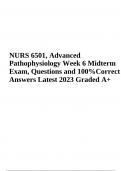
-
NURS 6501: Advanced Pathophysiology Week 6 Midterm Exam Questions and Correct Answers Latest 2023/2024 (Already Graded A+)
- Exam (elaborations) • 21 pages • 2023
-
- $26.99
- 8x sold
- + learn more
NURS 6501: Advanced Pathophysiology Week 6 Midterm Exam Questions and Correct Answers Latest 2023/2024 (Already Graded A+) A healthcare professional is educating a patient on asthma. The professional tells the patient that the most successful treatment for chronic asthma begins with which action? Avoidance of the causative agent Question 16 Selected Answer: A student asks the healthcare professional to explain the pathophysiologic process of alcoholic cirrhosis. What statement by the pr...
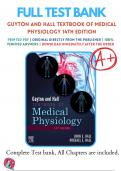
-
Test Banks For Guyton and Hall Textbook of Medical Physiology 14th Edition by John E. Hall; Michael E. Hall, 9780323597128, Chapter 1-86 Complete Guide
- Exam (elaborations) • 262 pages • 2023
-
- $28.40
- 2x sold
- + learn more
Guyton and Hall Textbook of Medical Physiology 14th Edition 7128 0039 6, 8, 0, 0039, 8390, 0060 1. Functional Organization of the Human Body and Control of the “Internal Environment” 2. The Cell and Its Functions 3. Genetic Control of Protein Synthesis, Cell Function, and Cell Reproduction 4. Transport of Substances Through Cell Membranes 5. Membrane Potentials and Action Potentials 6. Contraction of Skeletal Muscle 7. Excitation of Skeletal Muscle: Neuromuscula...
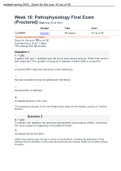
-
SCI 225 Pathophysiology - Week 16: Pathophysiology Final Exam (Proctored) Score for this quiz: 43 out of 50
- Exam (elaborations) • 25 pages • 2023
-
Available in package deal
-
- $9.49
- 3x sold
- + learn more
Week 16: Pathophysiology Final Exam (Proctored) Due Aug 20 at 5pm Attempt Time Score LATEST Attempt 1 89 minutes 43 out of 50 Correct answers are hidden. Score for this quiz: 43 out of 50 Submitted Aug 19 at 11:06pm This attempt took 89 minutes. Question 1 1 / 1 pts A patient with type 1 diabetes asks the nurse what causes polyuria. What is the nurse’s best response? The symptom of polyuria in diabetes mellitus (DM) is caused by: a reduced ADH response caused by insulin deficiency....
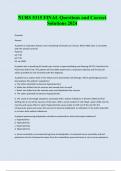
-
NURS 5315 FINAL Questions and Correct Solutions 2024
- Exam (elaborations) • 85 pages • 2024
- Available in package deal
-
- $12.99
- 1x sold
- + learn more
NURS 5315 FINAL Questions and Correct Solutions 2024 Question Answer A patient in respiratory distress and is breathing 33 breaths per minute. Which ABG value is consistent with the clinical scenario? PCO2 15 pH 7.30 pH 7.45 O2 sat 100% A patient who is breathing 33 breaths per minute is hyperventilating and blowing off CO2; therefore the PCO2 level will be low. The patient will most likely experience a respiratory alkalosis and the two pH values provided are not consistent with this...
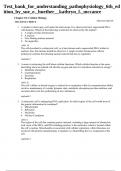
-
Test_bank_for_understanding_pathophysiology_6th_ed ition_by_sue_e._huether__kathryn_l._mccance
- Exam (elaborations) • 367 pages • 2024
-
- $16.49
- 1x sold
- + learn more
Chapter 01: Cellular Biology MULTIPLE CHOICE 1. A student is observing a cell under the microscope. It is observed to have supercoiled DNA with histones. Which of the following would also be observed by the student? a. A single circular chromosome b. A nucleus c. Free-floating nuclear material d. No organelles ANS: B The cell described is a eukaryotic cell, so it has histones and a supercoiled DNA within its nucleus; thus, the nucleus should be observed. A single circular chromosome ca...
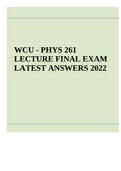
-
WCU - PHYS 261 FINAL EXAM LATEST ANSWERS 2023.
- Exam (elaborations) • 20 pages • 2022
- Available in package deal
-
- $18.49
- 17x sold
- + learn more
WCU - PHYS 261 FINAL EXAM LATEST ANSWERS 2022. ) Nucleic acids are polymers of units called A) ribose. B) bases. C) fatty acids. D) amino acids. E) nucleotides. 6) Cell membranes are said to be A) actively permeable. B) impermeable. C) freely permeable. D) selectively permeable. E) none of the above 7) In humans, only __________ cells have flagella. A) sperm B) intestine lining C) stomach lining D) respiratory tract lining E) two of the above 8) The addition of a phosphate grou...
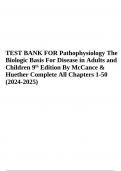
-
TEST BANK FOR Pathophysiology The Biologic Basis For Disease in Adults and Children 9th Edition By McCance & Huether Complete All Chapters 1-50 (2024-2025)
- Exam (elaborations) • 489 pages • 2024
-
- $34.49
- 1x sold
- + learn more
TEST BANK FOR Pathophysiology The Biologic Basis For Disease in Adults and Children 9th Edition By McCance & Huether Complete All Chapters 1-50 () Which statement best describes the cellular function of metabolic absorption? a. Cells can produce proteins. b. Cells can secrete digestive enzymes. c. Cells can take in and use nutrients. d. Cells can synthesize fats. ANS: C In metabolic absorption, all cells take in and use nutrients and other substances from their surroundings. The remaining...

How much did you already spend on Stuvia? Imagine there are plenty more of you out there paying for study notes, but this time YOU are the seller. Ka-ching! Discover all about earning on Stuvia


